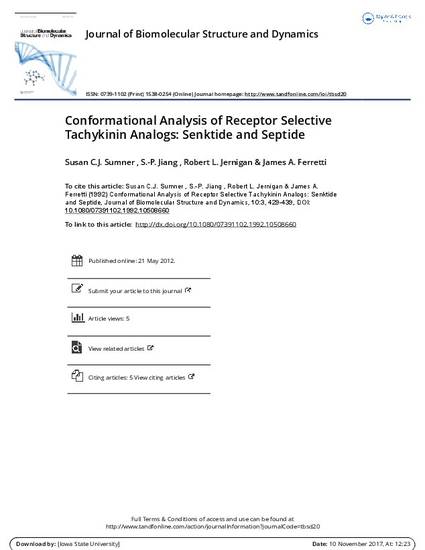
Article
Conformational Analysis of Receptor Selective Tachykinin Analogs: Senktide and Septide
Journal of Biomolecular Structure and Dynamics
(2012)
Abstract
The conformational behavior in solution of two receptor selective tachykinin agonists, senktide (succiny1-D-F-MeF-G-L-M-NH2) and septide (pQ-F-F-P-L-M-NH2) is described. Two dimensional cross relaxation NMR spectroscopy is used together with coupling constant data to obtain interproton distance constraints. These results are used in conjunction with semi-empirical energy computations to indicate favorable conformations. Senktide is found to have a high degree of conformational order which is attributed to rotational restriction associated with the N-methylation of phenylalanine. The lowest energy conformation in accord with the experimental interproton distances contains a β-turn. Interproton distances indicate that septide exists as a random coil or in an extended chain conformation. Energy computations suggest that septide is primarily an extended chain with internal reorientation restricted by the proline residue. These results may be related to the selectivity of these peptides for different receptors, in that the analogs, with conformations more stable than tachykinins, are more receptor selective.
Disciplines
Publication Date
May, 2012
DOI
10.1080/07391102.1992.10508660
Publisher Statement
Works produced by employees of the U.S. Government as part of their official duties are not copyrighted within the U.S. The content of this document is not copyrighted.
Citation Information
Susan C. J. Sumner, S. P. Jiang, Robert Jernigan and James A. Ferretti. "Conformational Analysis of Receptor Selective Tachykinin Analogs: Senktide and Septide" Journal of Biomolecular Structure and Dynamics (2012) p. 429 - 439 Available at: http://works.bepress.com/robert-jernigan/109/
